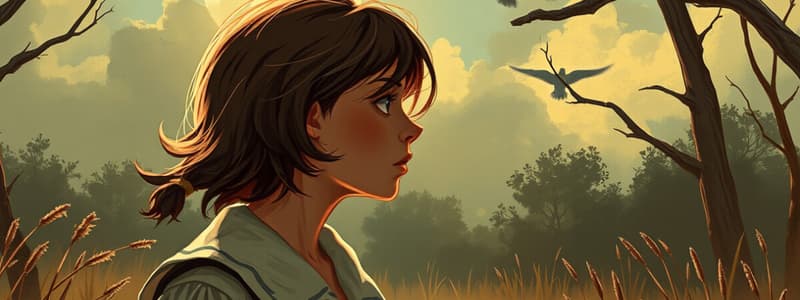Podcast
Questions and Answers
What two images come to mind as Scout is falling asleep? What are they and why do they cause her to cry?
What two images come to mind as Scout is falling asleep? What are they and why do they cause her to cry?
Scout remembers Atticus calmly folding his newspaper and pushing back his hat, and the scene just before Atticus killed the rabid dog. She cries because she realizes the extent of the danger that Atticus faced.
What surprising fact does Atticus reveal about Mr. Underwood at the breakfast table? What previously mentioned theme is emphasized by this information?
What surprising fact does Atticus reveal about Mr. Underwood at the breakfast table? What previously mentioned theme is emphasized by this information?
Atticus reveals that Mr. Underwood despises Negroes but is loyal to his friends, emphasizing the theme that good and evil coexist in all people.
What does Atticus say about mobs and men over the breakfast table? What does he mean by the statement, '[M]aybe we need a police force of children...'?
What does Atticus say about mobs and men over the breakfast table? What does he mean by the statement, '[M]aybe we need a police force of children...'?
He says that mobs are made up of men who have blind spots about their actions, meaning children are innocent and unknowing.
What is the mood in the courthouse square on the first day of the trial? What, if anything, do you find disturbing about it?
What is the mood in the courthouse square on the first day of the trial? What, if anything, do you find disturbing about it?
What is significant about Mr. Dolphus Raymond?
What is significant about Mr. Dolphus Raymond?
According to Jem, what are 'mixed' children, and why are they sad?
According to Jem, what are 'mixed' children, and why are they sad?
Compare and contrast the behavior of the white spectators to that of the black spectators.
Compare and contrast the behavior of the white spectators to that of the black spectators.
How are blacks and whites segregated inside the courthouse? Where do Scout, Jem, and Dill end up sitting?
How are blacks and whites segregated inside the courthouse? Where do Scout, Jem, and Dill end up sitting?
How does Scout describe the Maycomb County courthouse? According to her, what do the Greek revival columns and the old clock tower suggest about the people of Maycomb?
How does Scout describe the Maycomb County courthouse? According to her, what do the Greek revival columns and the old clock tower suggest about the people of Maycomb?
Describe the members of the Idlers' Club. What information does Scout get from them? What is it that confuses her?
Describe the members of the Idlers' Club. What information does Scout get from them? What is it that confuses her?
Flashcards are hidden until you start studying
Study Notes
Scout's Reflections
- Scout recalls Atticus's calm demeanor when confronted by an angry mob, leading to her tears as she grasps the danger he faced.
- Another poignant memory involves Atticus killing a rabid dog, highlighting the serious threats he confronts in their society.
Mr. Underwood's Complexity
- Atticus reveals that Mr. Underwood is a racist who despises black people but displays loyalty to friends, illustrating the theme that good and evil coexist within individuals.
Mobs and Innocence
- Atticus discusses how mobs consist of men who can overlook the morality of their actions, suggesting they have "blind spots."
- He posits that children might serve as a moral compass, implying their innocence contrasts with adult prejudice and blindness.
Courthouse Atmosphere
- The mood in the courthouse square is festively inappropriate given the serious context of the trial, amplifying the disconnection of the spectators from the gravity of the situation.
Mr. Dolphus Raymond's Significance
- Mr. Dolphus Raymond is notable for associating predominantly with black people and having a mixed-race family, challenging societal norms of racial segregation.
Sadness of Mixed Children
- Jem describes "mixed" children as sad because their biracial status prevents them from fully belonging to either race, highlighting issues of identity in a divided society.
Spectator Behavior
- White spectators maintain a lighthearted atmosphere while black spectators remain subdued, reflecting racial tensions and differing societal attitudes toward the trial.
Courthouse Segregation
- Inside the courthouse, racial segregation is evident; white attendees enter first, while black spectators wait. Scout, Jem, and Dill ultimately sit in the balcony, reinforcing the social hierarchy.
Description of the Courthouse
- Scout describes the courthouse as architecturally eclectic, symbolizing the town's unwillingness to move beyond its historical past, which resonates with a central theme of the story.
Idlers' Club Dynamics
- The Idlers' Club consists of older men who loiter in the courthouse, discussing court proceedings and displaying a lack of engagement with the seriousness of the trial, particularly the defense of Tom Robinson.
Studying That Suits You
Use AI to generate personalized quizzes and flashcards to suit your learning preferences.




